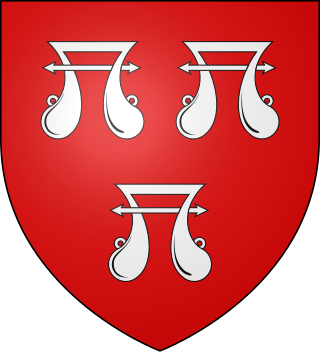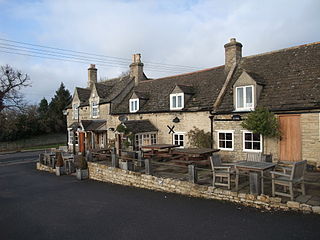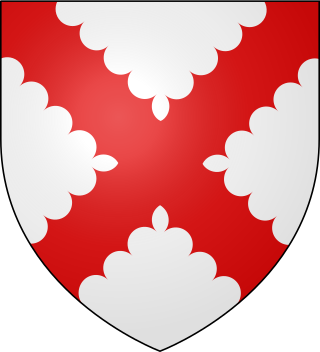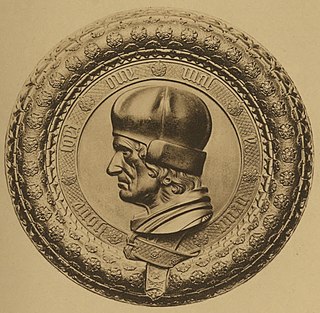
Woodstock Palace was a royal residence in the English town of Woodstock, Oxfordshire.

Edmund Ros or Roos, 10th Baron Ros of Helmsley was a follower of the House of Lancaster during the Wars of the Roses. He regained his family title after the accession of King Henry VII of England.

Thomas Manners, 1st Earl of Rutland, 12th Baron de Ros of Helmsley, KG, of Belvoir Castle in Leicestershire, was created Earl of Rutland by King Henry VIII in 1525.

Collyweston is a village and civil parish in North Northamptonshire, about three miles southwest of Stamford, Lincolnshire, on the road to Kettering. The population of the civil parish at the 2011 census was 514.
Sir Richard Lee (1513–1575) was a military engineer in the service of Henry VIII of England, Edward VI and Elizabeth I. He was a commander of Henry VIII and appointed surveyor of the King's works. Lee was member of parliament for Hertfordshire in 1545. He was the first English engineer to be knighted.
Andrew Windsor, 1st Baron WindsorKB (1467–1543), was a Member of Parliament, English peer, and Keeper of the Wardrobe, knight banneret and military commander.

John Tiptoft, 1st Baron Tiptoft was a Knight of the Shire for Huntingdonshire and Somerset, Speaker of the House of Commons, Treasurer of the Household, Chief Butler of England, Treasurer of the Exchequer and Seneschal of Landes and Aquitaine.

The title Baron Grey of Powis (1482–1552) was created for the great-grandson of Joan Charleton, co-heiress and 6th Lady of Powis (Powys) and her husband, Sir John Grey, 1st Earl of Tankerville (1384–1421) after the death of Joan's father, Edward Charleton, 5th Baron Cherleton (1370–1421) left the title in abeyance.

Sir Anthony Browne, KG of Battle Abbey and Cowdray Park, both in Sussex, England, was a Member of Parliament and a courtier who served as Master of the Horse to King Henry VIII.

Sir Thomas Lovell, KG was an English soldier and administrator, Speaker of the House of Commons, Secretary to the Treasury and Chancellor of the Exchequer.
Enfield-chantry school was a chantry school in Enfield from c. 1398–1558, and the predecessor of Enfield Grammar School.
Sir William Boleyn, KB of Blickling Hall in Norfolk and Hever Castle in Kent, was a wealthy and powerful landowner who served as Sheriff of Kent in 1489 and as Sheriff of Norfolk and Suffolk in 1500. He was the father of Thomas Boleyn, 1st Earl of Wiltshire, whose daughter was Queen Anne Boleyn, the second wife of King Henry VIII.

Forty Hall is a manor house of the 1620s in Forty Hill in Enfield, north London. The house, a Grade I listed building, is today used as a museum by the London Borough of Enfield. Within the grounds is the site of the former Tudor Elsyng Palace.
Sir William Hawte was a prominent member of a Kentish gentry family of long standing in royal service, which, through its near connections to the Woodville family, became closely and dangerously embroiled in the last phases of the Wars of the Roses.
Sir Thomas Wroth was an English courtier, landowner and politician, a supporter of the Protestant Reformation and a prominent figure among the Marian exiles.
George Owen (1499–1558), from Oxford and Godstow, Oxfordshire, was an English royal physician and politician.
Edward Lewknor was the representative of a branch of a prominent Sussex family, in an armigerous line descending in the distaff side from the Camoys barony. Having attained standing as a member of parliament and by a position of service in the royal household, his career was ended abruptly by his involvement in Henry Dudley's conspiracy against Queen Mary I, and his consequent attainder. His children were restored in blood by Queen Elizabeth I.

Ipswich Greyfriars was a mediaeval monastic house of Friars Minor (Franciscans) founded during the 13th century in Ipswich, Suffolk. It was said conventionally to have been founded by Sir Robert Tibetot of Nettlestead, Suffolk, but the foundation is accepted to be set back before 1236. This makes it the earliest house of mendicant friars in Suffolk, and established no more than ten years after the death of St Francis himself. It was within the Cambridge Custody. It remained active until dissolved in the late 1530s.
Sir John Wolstenholme, 3rd Baronet (1649–1709), of Forty Hall, Enfield, and Denmark Street, St. Giles-in-the-Fields, Middlesex, was an English landowner and Whig politician who sat in the English and British House of Commons between 1695 and 1709.
Robert Wroth was an English courtier and Member of Parliament for Newtown.










